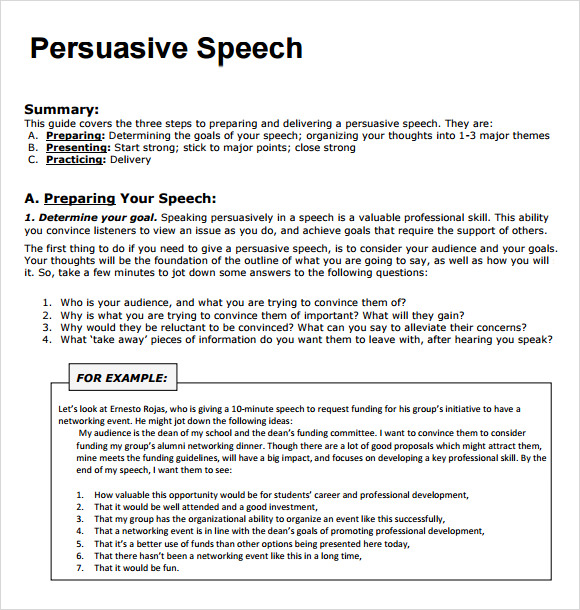May 25, 2018 Topics For a Persuasive Speech. Good persuasive speech topics. Why should a teacher be the most well-paid job? Reasons why financial literacy is important in the society. Why sex education should be a part of a curriculum. 5 facts to prove that women could be better leaders. Why religion is a private issue of a person. How to write a good persuasive speech Persuasive speech is meant to convince the audience to adopt a particular point of view or influence them to take a particular action. There are many instances that might require you to write a persuasive speech, especially in academic programs. It is important to understand how to structure and present a persuasive speech to.

Motivating others can be difficult under the best of circumstances, but giving a persuasive speech can feel downright impossible.
People can hold onto their stance with absolute conviction. If you’re trying to persuade them that they can lose weight or to take a stand against bullying, they might cross their arms and state that things can’t change from how they are.
This is why it can seem like a good idea to write out an outline first. But what is the flow of a speech that truly inspires? What does a solid persuasive speech outline actually look like?
Most people think that this type of content has to have an elaborate organizational pattern to it. But that’s just not true of the most effective speech outlines. Persuasive speech is about convincing them of a different possibility for their lives, and it’s something you can do in three simple parts.
Below is a 3-part framework that you could put together for your topic in 5 minutes.

Part 1: Establish a problem they care about solving
One of the biggest mistakes public speakers make when trying to convince others of something is that they delve right into their solution. But this is just going to make people cross their arms even tighter. They have their perspective because they’ve had a lifetime of experiences convincing them that they’re right.
If they’ve struggled with obesity their whole life, they have plenty of evidence to tell them they can’t lose weight. But they still care about being healthier.

People are most likely to embrace a solution when it’s presented within the context of a problem they care about solving. The most persuasive speeches first meet the audience where they’re at – not where the speaker wants them to be.
Part 2: Identify typical solutions
The reason why people don’t embrace new solutions is that they don’t believe it will lead to change. Someone adamant about every diet being worthless feels that way because they’ve tried all of the diets and it hasn’t helped them keep the weight off.
But this actually becomes an opportunity to set up your solution. If you identify the false ways that people try to solve the problem in question, you’re showing your audience that the problem isn’t them. You’re showing them that the problem is in the solution. This lets them off the hook, which builds a sense of hope.
Part 3: Explain your solution
Now, finally, we’ve gotten to the part that most people start with. The solution. The steps, components, or other information that you’ve spent so much time developing. But the previous two parts of this framework are meant to help you to create an absolutely critical element in your speech: hunger for your solution.
So a speech outline example might look like this:
Preparation Outline For Persuasive Speech
- Establish the problem of being overweight: Explore how difficult it can be to lose weight and the heavy emotions associated with it.
- Identify typical solutions around weight loss: Present several diets and approaches to weight loss that don’t work and why they fail.
- Describe your solution: Share a case study of someone who implemented this idea and the results they got and explain why it worked.
Then, you might provide a call-to-action at the end, prompting the audience to take next steps with you. But notice that this speech outline isn’t even 75 words long. If you have clarity around your audience’s problems, you can easily formulate a truly persuasive speech outline in under five minutes.
A Good Outline Ofr A Persuasive Speech Outline
But now that you’ve figured out the general flow of your speech, how do you start it? Most speakers make a critical mistake in the first 15 seconds of their speech. Click below to find out how to avoid making this common mistake.